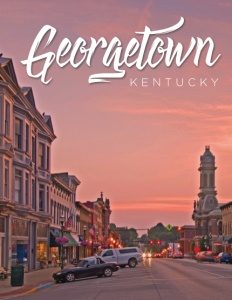Business View Magazine interviews Kyle Goodwin, City Engineer of Georgetown, Kentucky, as part of our series on vibrant American cities.
Georgetown Kentucky, a city of 34,000, situated in the north central part of the state, is the seat of Scott County. The settlement was originally called Lebanon, when it was first founded by Rev. Elijah Craig in 1782, who also built a distillery in 1789, as well as a school called the Rittenhouse Academy, which eventually grew into Georgetown College. Lebanon was renamed George Town in 1790 in honor of President George Washington, and its name was officially shortened to Georgetown in 1846.
Following the Civil War, Georgetown became a railroad hub, connected to the Cincinnati Southern, the Louisville Southern, and the Frankfort & Cincinnati, which was considered the “whiskey route,” bringing much of the region’s bourbon to market. Throughout the 20th century, the city has been transitioning from an economy based primarily on agriculture, to a diversified one mixing manufacturing, and small business with the family farm. During the 1960s, the construction of U.S. Interstate 75 placed the city on one of the busiest highways in America, and the selection of Georgetown as the site of Toyota Motor Manufacturing Kentucky in 1985, has resulted in the greatest period of growth in the city’s history. Still growing, Georgetown has a projected population of over 40,000 by 2020.
Recently, Business View Magazine spoke with Kyle Goodwin, Georgetown’s City Engineer to find out what new municipal projects were either planned or ongoing in the city, as well as his role in them. The following is an edited transcript of that conversation:
BVM: We understand you’ve been City Engineer for about five years. Tell us a little about the job.
Goodwin: “As a typical city engineer, I wear a lot of hats. I’m in charge of our capital improvement program; I’m the pavement management system manager; I manage our encroachment permits; manage our street light program; I’m on the traffic committee, and recently, I’ve been managing software implementation for asset management and work order systems. I also assist the City Attorney in drafting and revising ordinances and I manage four budgets: engineering, stormwater, landfill, and the municipal aid program.
“I’m also our MS4 Phase II coordinator.” (MS4 stands for Municipal Separate Storm Sewer System. An MS4 is a conveyance or system of conveyances that is owned by a state, city, town, village, or other public entity that discharges to waters of the U.S., and is not part of a publicly-owned sewage treatment plant. Phase II, issued in 1999, under the Clean Water Act, requires regulated small MS4s in urbanized areas to obtain NPDES ((National Pollutant Discharge Elimination System)) permit coverage for their stormwater discharges. There are nearly 100 Phase II MS4 programs in the State of Kentucky.)
BVM: That’s seems more like a whole hat shop. Why so many?
Goodwin: “One of the underlying issues in Georgetown, which can be looked at as both positive and negative, is we’ve always been a small town, so we’ve had a small-town mentality and that clashes with the growth that we’ve seen. Georgetown is a fast growing city in one of the fastest growing counties in the state. I think we’re ranked 9th or 8th most populous, and we’ll be the 6th in the next ten to fifteen years assuming constant growth at our current rate. But, we are pretty well understaffed; we’ve had about the same number of employees since 2000, and the City Engineer’s Office has been a department of one until about three years ago, when I was able to get an engineering technician into the budget. That said, we’ve a lot to do and not that many people to do it. So, we do rely heavily on the private sector to assist us with a lot of those things that some city departments may do internally.”
BVM: You say that you have a lot to do. Can you talk about some of the projects on your agenda?
Goodwin: “This year, we’re undertaking Phase II and Phase III of our Lanes Run Business Park expansion. In 2003, Toyota Manufacturing and the City of Georgetown split the cost to purchase about 600 acres of property. It’s going to be zoned BP-1, which is a light industrial, business-type transition area, to try and bring in light manufacturing, production, prototype facilities, research and development, and professional training facilities. Most of the infrastructure from Phase I has been in for awhile, and we have a number of private industries out there, already. We are running out of space and this project will allow us to continue supporting the growth we are seeing.
“One key project that just finished construction, this past year, was the Bluegrass Community and Technical College (BCTC). They built a Bluegrass Advanced Manufacturing Center that was a collaboration between Toyota and BCTC. What they’re trying to do is develop the expertise in the growing population for jobs at Toyota and its secondary and tertiary support industries. Toyota takes up about a fifth to a quarter of the land mass of Georgetown, and it’s our primary economic driver, so that’s a pretty important project.
“We just hired an engineer to plan out Phases II and III of this business park, and right now, we’re looking at about a $7 million project to spend on streets, infrastructure, water and sewer, electrical – the whole nine yards – and that’s going to expand the park, which is pretty much built out with the industries and offices that are already in that area. The engineer is HDR Incorporated, and we just signed a contract with them, so we should be having preliminary meetings coming up, shortly.”
BVM: Any other economic drivers on the horizon?
Goodwin: “Something that recently has been coming back to Georgetown is brewing and distilling. You know, Georgetown claims –and I’m fully behind that claim – that we’re the birthplace of bourbon. We have a distiller trying to get in here, downtown, to produce bourbon. It takes awhile for that to get set up, so they’re not quite in place to do that yet. But we have Country Boy Brewing – they just opened their second brewery out in the business park. They’ve got a tasting bar, and I think they’re actually going to be growing their hops, out there. So, that’s interesting.”
BVM: Does Georgetown have a downtown core that’s ripe for redevelopment?
Goodwin: “I would say we’re on the cusp. Our downtown is not a big one, but there’s plenty of area for redevelopment, and what’s been happening recently is we’ve had more restaurants come downtown – non-chain restaurants. So, we’ve seen an increase in pedestrian and vehicular traffic. I’m not sure we have the housing there, yet, and I’m waiting for something like that to happen, because with all the experience-focused things that are coming downtown, I would assume that’s going to follow.
“This past year, the mayor met with students from a the University of Cincinnati; they spent a lot of time downtown, taking pictures and looking at planning documents, and tried to envision how to transform downtown Georgetown into a more modern city. They presented that report this past winter. They were great ideas, but when you’re looking at a $30 million price tag for a city with a $25 million budget. . .
“But one project we are getting ready to start: we recently received a TAP (Transportation Alternatives Program) Grant from the Kentucky Transportation Cabinet. We had planned three phases at a total of about $2 million. For the first phase, we’ll receive $720,000; it will include pedestrian access improvements, walkability improvements, traffic calming, stormwater, and infrastructure improvements at the entrance to the city on the western side. And we’re going to rehabilitate the historic stack stone bridge that we have. The Royal Springs aquifer goes from Lexington to Georgetown and the spring is here. That spring is what our water company uses to produce finished water for most of the city. From there it goes through Royal Springs Park and then through a viaduct underneath the stack stone, historic bridge. So, we’re going to improve that area, add lighting, and try and slow some of the vehicles coming into town.
“It’s actually quite timely because our main downtown restaurant just relocated to where the bridge ends and you enter downtown Georgetown, proper. We had a lot of issues with pedestrians trying to cross the street and so this TAP Grant is going to help with that intersection and farther west of town.
“And Royal Springs Park was included in the project that the University of Cincinnati students completed and I have some money in the budget, this year, to hire an engineer for a feasibility study on implementing a part of that project – a cityscape on North and South Water Streets. These two streets line up against where Royal Springs comes out, and we think that will tie in nicely to what we’re doing with the TAP Grant.
“We’ve got one other project I’d like to talk about: it’s called the Lemons Mill Road widening project. The project estimate is about $650,000. We’re under contract with the engineer, ECSI, and we currently have our final plans about complete. The State Department of Transportation is reviewing those plans now. And what’s interesting about this project is the funding. We have more than half of the budget from the state; we have money from the city and the county, and we have funding from the local industries that would benefit from it. These businesses run trucks 24/7, so right now, they’re on an old state road that’s two lanes wide and they have difficulty getting onto the bypass, which is also a state road. Additionally, the intersection with the bypass is one of our higher accident rate areas in the city. This plan is to widen it, put in turn lanes, a center lane, and try and improve the vehicular flow in that area while also improving safety at the intersection.”
BVM: Does Georgetown have any green or sustainable projects planned or ongoing?
Goodwin: “Whenever we do a project, we do try to add sustainable practices, but it typically comes down to funding and some of those items get cut. But my goal with the North and South Water Streets project is to include some of those items, especially since we’re down by the spring.
“This past year, we received a Source Water Protection grant from the State Division of Water; we have an area out by our ballpark – about 14 acres – which drains into a sinkhole and goes directly to the spring. So, we developed a large rain garden there to improve the quality of stormwater entering our drinking water. We had students from Georgetown Middle School come out and help plant about a thousand plants and we’re in the process of putting up signage to explain the path of water, the whole ecological cycle, how Royal Springs received water through our karst geology, and how we use water.
“We’re also doing a stormwater watershed study; we’ve hired a stormwater consultant and we started a stormwater master plan. We had people from Toyota, Georgetown College, city officials from different departments, and other private entities discuss how we approach our five main watersheds. As part of our MS4 program, we have to try and clean things up and fix infrastructure and plan for the future. Do we need to add more regulations or sustainable practices so that we prevent downtown flooding; or prevent getting pollutants from an industrial area into a non-industrial area? That study is an ongoing process – probably for five years.
“But, we did start a pilot project, this past year. We could only fund two of the sub-basins out of about 30 within those five watersheds, and what we’re doing is locating all of our structures, and inspecting them. We hired Leak Eliminators out of Lexington and they go around and close-circuit TV all the pipes, and they also clean all the pipes. And we’re going to take all those video inspections and come up with a project list and pull it all together for the whole watershed, and try and understand where to focus our money and what the problems are in the area. And then, coming out of that, we can start implementing green practices to try and solve some of those issues. We expect that whole project to last five to seven years at about $2.3 million.”
BVM: Thanks Kyle; that gives us a lot to think about. We appreciate your time, this morning. And good luck with all those hats.
Goodwin: “It was great talking to you. Have a good one.”
AT A GLANCE
WHO: Georgetown, Kentucky
WHAT: A city of 34,000
WHERE: In Scott County, in the north central part of the state.
WEBSITE: www.georgetownky.gov





